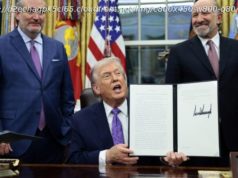As in the case of data about climate change and occupational safety, the Trump administration has quietly pulled down bleak numbers about electricity and drinking water after Hurricane Maria.
In the aftermath of a major disaster, the federal government plays two essential roles: Get material help to the victims, and convey a sense of comfort and support. Should either of those not go according to plan, there’s always a third option: Quietly disappear anything that might reflect poorly.
Religious Liberty or Discrimination?
With the post-Hurricane Maria relief effort in Puerto Rico still a long way from complete, there are sobering statistics about conditions on the island. Less than 11 percent of people have electricity. Just 42 percent have working phones. Barely half have access to drinking water. And until this week, anyone visiting FEMA’s page for the Maria recovery effort could have found that information. But then, as The Washington Post first noticed, they’re gone now. FEMA still has some information there, including road status, but the bleakest numbers are gone.
FEMA’s answer is that the numbers are all available on an official Puerto Rican page, which is true . “Our mission is to support the governor and his response priorities through the unified command structure to help Puerto Ricans recover and return to routines. Information on the stats you are specifically looking for are readily available,” a spokesman told the Post. That’s all fair enough, but it doesn’t explain why FEMA was posting those numbers, or why it stopped now.
The deletion of the statistics both fits with the Trump administration’s pattern of treating Maria largely as a matter of so-called optics, the concern with how things look rather than how they are, and with its past tendency to remove public posting of data that cuts against its message in other realms. As a federal project, Maria poses a particularly difficult task: The scale of the destruction on Puerto Rico is bad, even for a major hurricane, and the territory’s remoteness makes it harder to move resources to than other American land. Brock Long, the head of FEMA, has described it as the biggest logistical challenge in American disaster history, and experts broadly agree. As both professional disaster managers and journalists like me have pointed out, while any delay is frustrating to those enduring it, the difficulties are real.
The problem is that faced with this trouble, the White House has, rather than acknowledging the challenges and offering comforting words, simply insisted that everything is copacetic. President Trump has struck a celebratory tone about the relief effort and criticized Puerto Rican officials for failing to do enough, and he picked a strange social-media fight with the mayor of San Juan. This was followed by a tone-deaf visit to the island, in which he solicited compliments on federal relief and tossed paper-towel rolls into a crowd before leaving the island ahead of schedule. In general, the president has appeared more deeply concerned with the political perception of his actions than about the state of the recovery.
That context makes it hard to approach the removal of Puerto Rico recovery data from the FEMA site without suspecting the goal is to put a more positive spin on messaging. It’s also hard to interpret the move outside of the Trump administration’s pattern of removing data from public websites when it undercuts the official line.
The most high-profile removals have concerned climate-change data, removed from several agency sites. Many high-level Trump officials have expressed skepticism about the changing climate, and the president has in the past called it a “Chinese hoax.” National Park Service tweets about climate change also disappeared .
The administration has also removed records about animal-welfare violations recorded by the federal government. A counter of workplace deaths has been scrubbed from the site of the Occupational Safety and Health Administration. Energy-efficiency data is also gone.
Like the Puerto Rico statistics, it’s a soft sort of secrecy. The underlying data has not, as far as is known, ever been deleted, and it’s often a matter of public record. But the administration is often not legally required to make that information available online. By taking it down and making it something the public must request, or by removing information from a FEMA page and leaving a Spanish-language resource to take its place, the executive branch is wagering that simply making these records harder to see will help to sweep any criticism or public backlash a little farther out of sight.
In some cases, that may be right. In others, such as the FEMA data, the administration is caught in the act—and, ironically, that makes for bad optics.






